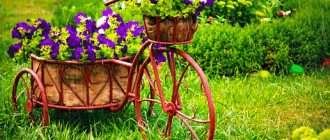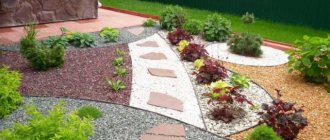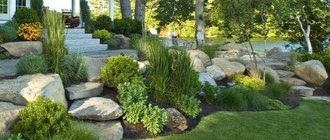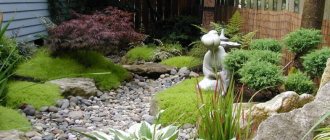A mixborder of perennials is decorative at any time of the year. That is why such a flower garden is very popular in landscape design. Creating a flower bed from many different and seemingly completely incompatible species and varieties of ornamental plants is an entire art.
When creating a mixborder from perennials with your own hands, the main thing is to stock up on theoretical knowledge and be patient. And in subsequent years you will admire the almost continuous flowering of your favorite plants.
Features of creating a “mixed” flower garden
The diversity of a mixborder is not a chaotic planting of a large number of plants of different species. Their sizes are also of great importance here. Tall people can go well with short people. Your task is to make the composition harmonious and beautiful.
How to make a beautiful mixborder from perennials, if here some flowers replace others? And those that bloomed in June should not “spoil” the appearance of the flowerbed in August? This is not allowed with a mixborder!
Thanks to the decorative nature of the leaves, some plants remain quite attractive even after flowering. The remaining leaves may not serve as a special decoration for the flower garden, but they remain neat and do not spoil the overall appearance.
Some perennials should not be planted in large masses in “mixed” flower beds. It is impossible to take your eyes off delphiniums, for example, during flowering. But after flowering, it is better to cut off their extinct flower stalks. This is easy to do if single specimens were planted. The resulting voids will always be covered by other plants. But, if several delphinium bushes were planted, it will be difficult to cover a large number of cut plants.
If, when creating a mixborder, it is not possible to select perennial plants that replace each other, then you can plant a small number of annual crops that will distract the eye from faded perennials.
Description
Mixborders in landscape design appeared in the 17th century. The concept itself comes from the French language. “Mix” is translated as “mixing”, and “border” is translated as “border”, “restriction”.
Today, a similar term denotes a flowerbed of any configuration, consisting of all kinds of vegetation, planted in a certain order.
In other words, modern gardeners understand a mixborder as a complex flower garden consisting of annuals, perennials, shrubs and herbs.
Such a landscape element is characterized by the combination of a number of varieties of green spaces, different in shape, size, color, and foliage texture.
The difference from a border or ridge is that planting in such a floral composition is carried out in a free, natural style.
Flowers are arranged in groups, with smooth transitions between them, without sudden changes in color and height.
At the same time, when planting them, it is necessary to focus on a carefully thought-out plan that takes into account many complex nuances.
The peculiarity of the mixborder is as follows: due to the well-chosen composition and correct layout, it retains its decorative properties throughout the season.
A similar flower garden looks equally attractive in both spring and autumn. Plantings are done in tiers, placing tall flowers in the background and low-growing flowers in the foreground.
The main stages of arranging a continuous flowering mixborder
First of all, you need to choose a place where the mixborder will be installed. This seemingly simple task is, in fact, very important. A mixed flower bed cannot be placed wherever you please. For perennial crops, the conditions surrounding them are very important.
Flower beds of free outlines should not be placed under the scorching rays of the sun or in damp, constantly shaded places. Everything should be in moderation. The optimal conditions for a mixborder of perennials will be open areas with moderate lighting.
Please note the following options:
- along the facade of the house;
- on a slight rise;
- on the edge of the terrace;
- as a living fence around the perimeter of the entire site;
- against the backdrop of the lawn;
- along garden paths.
The length of the mixborder is not limited, and depending on the types of plants, one part of it can be located in the sun, and the other in partial shade.
Along the fence
The mixborder in the diagram below, the most successful location of which will be along the fence, consists of:
- Derena cornus alba Gouchaulti,
- Derena Sibirika,
- Diablo bladderwort,
- Tui Smagard,
- Spiraea Vangutta or Chubushnik,
- Thuja occidentalis Hoveyi,
- Euonymus Fortune variety Aurea Variegata,
- Sedum prominent,
- Heucheras,
- Hosts,
- Astilbe,
- Siberian iris,
- Peonov,
- Hortensius.
Design of the central part of the mixborder
The following ornamental trees and shrubs of deciduous or coniferous species can be planted as a basis:
- willow;
- viburnum;
- plum with red leaves;
- elder;
- magnolia;
- dwarf cedars, firs and thujas;
- jasmine;
- hibiscus;
- weeping larch.
They are planted at a certain distance from each other because they tend to grow. To rejuvenate and prolong flowering, these plants require timely pruning.
From conifers and shrubs
Scheme No. 1 - ceremonial mixborder for a large area:
- Thuja western Holmstrup (occidentalis Holmstrup),
- Vertical juniper Krakovica (juniperus communis cracovica),
- European larch Pendula (larix deldua pendula),
- Prickly spruce Glauka (picea pungens glauca),
- Darts Gold (physocarpus opulifolius darts gold),
- Serbian spruce Pendula (picea omorika pendula),
- Canadian spruce Glauka Konika (picea glauca conica),
- Catnip Fassena Walkers Low (nepeta x faasenii walkers low),
- Dwarf oregano (origanum vuigare thumbles),
- Wittrock violet (viola x wittrockiana).
Scheme No. 2. Small mixborder along the wall at the entrance to the house:
Willow Snow fountain Weeping cherry Snow fountain, azalea, juniper Blue star, cotoneaster, dianthus, hemlock tsuga Canadensis pendula, dwarf blue spruce, heather, hinoki false cypress false cypress), euonymous, dwarf Japanese red pine.
Scheme No. 3. Perennials and annual flowers:
Original version. Flyers can be changed from year to year, each time getting a new look.
This mixborder uses:
- Thuja orientalis Aurea Nana (Chinese thuja aurea nana),
- Juniper medium Pfitzeriana glauca (phitzer juniper pfitzeriana glauca),
- Juniper blue star,
- Chinese juniper stricta (chinese juniper stricta),
- Flowers: Marigold (French marigold), Pinky annual phlox, Salvia officinalis blaze of fire.
Scheme No. 4. Emphasis on stones and bright maples:
Dwarf conifers and Japanese maples were used. This mixborder includes: Mountain pine Gnome (Pinus mugo Gnom), which can be replaced with mountain pine of the Mops or Ophir variety: Korean fir Tundra; Shirasawa maple (Acer shirasawanum).
Arrangement of the middle tier of the mixborder
Tiering is an important principle for creating a mixed flower bed. Therefore, it is necessary to cover the elongated stems of “skeletal” trees and shrubs with medium-sized varieties of perennial plants. It can be:
- phlox;
- roses;
- delphiniums;
- asters and many other colorful perennials.
The combination of bright colors and lush greenery is a good solution when creating mixborders from perennials with your own hands. Therefore, you can dilute the beautiful flowers of the middle tier with the chic foliage of the following plants:
- majestic geranium;
- juniper;
- silvery leaves of cineraria;
- burgundy heuchera leaves, as well as many other plants with decorative foliage.
Care instructions
Plants used to create a mixborder must be provided with proper care. In order for the flower garden to maintain an attractive appearance for as long as possible, the gardener will need to regularly carry out the following procedures:
- Trimming. Wilted flowers, dry leaves and weak shoots should be promptly removed. Shrubs that require formative pruning need to be periodically shortened.
- Pest control. Specialized preparations should be used to kill parasites.
- Fertilizer application. It is recommended to fertilize the plant during the flowering period using special compounds that promote the appearance of beautiful inflorescences. It is advisable to apply potassium and phosphorus-containing fertilizers in the summer. In autumn and spring, plants should be fed with compost.
- Loosening the soil. It is necessary to carry out this procedure so that after watering the soil does not form lumps. Loosening should only be done when the soil is dry. After the plants grow, there is no need for this procedure.
- Removing weeds. This procedure can be carried out while loosening the soil. It is recommended to remove weeds along with the roots. At the same time, it is undesirable to use herbicides in the fight against weeds, since they can harm the plantings.
- Regular watering. The frequency of the procedure is determined based on the individual needs of the selected plants.
Mixborder foreground design
Borders of mixed flower beds require special attention. It is better to frame the flower bed from plants with bright flowers and lush green leaves. The following plants can be planted in front:
- horned violet;
- bell;
- asters;
- hybrid carnation;
- irises;
- lilies, etc.
To make the overall picture of the flower garden more elegant, you can plant variegated annuals between the perennial plants. Spring primroses should smoothly pass the baton to plants that actively bloom in the summer. And those will give way to autumn-flowering species of perennials.
Color solutions for mixborders
The combination of shades is an important point in the design of “mixed” flower beds. The flower garden should fit well into the overall design of the garden plot. When designing a mixborder, you can use the following color combinations:
- the most successful combinations of spring freshness are blue and white shades: daisies with snowdrops or delphiniums, as well as white tulips with pale blue bells;
- For romantics, lilac, soft pink and scarlet colors of flowers are suitable. Pink phloxes, for example, will give a great mood in combination with irises or roses, with lilac bushes or lilies;
- the effect of a flaming flower garden can be created using orange, bright yellow and red shades. For example: the center of the circle is red, which is framed by orange shades, and plants with yellow flowers complete all this beauty. For such a composition you can plant gerberas and asters.
From shrubs and perennial flowers
Option 1.
Sedum or Sedum (from Latin Sedum), burnet, which also has such names as redhead, bebrenets, button, owl grass, black grass; semi-climbing white roses or park roses (WHITE FLOWERING SHRUB ROSA); evergreen boxwood (BUXUS SEMPERVIRENS HEDGE); climbing honeysuckle (LONICERA SP CLIMBER)
Option 2.
Sweet potato morning glory (Ipomoea batatas), purple supertunia, distinguished by large flowers (Supertunias), day lily (Day Lillies), Jackman's Clematis, or Jackmanii Clematis, gray fescue grass (Blue Fescue Grass).
Option 3.
The mixborder in the diagram below consists of: Barberry Rose Glow (berberis thubergii Rose Glow), Lobelia (Labelia speciosa Bees Flame), Lingularia dentate Desdemona, Monarda Prairinacht, Helenium Moertheim Beauty, Cannes Indian Wyoming (Canna indica Wyoming), Eupatorium maculatum Atropurpureum, Red Baron Imperata, George Davidson Crocosmia and a group of paniculate phlox.











